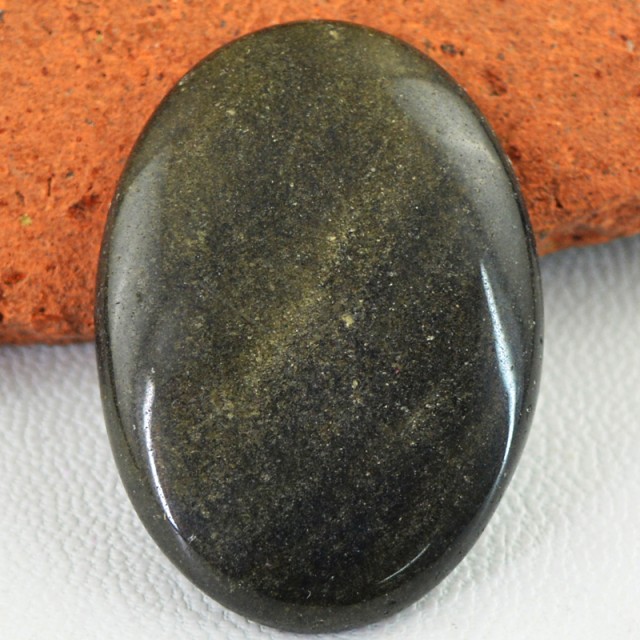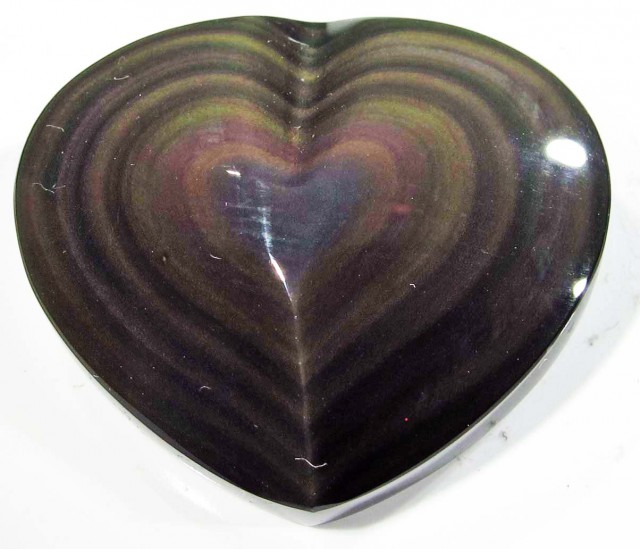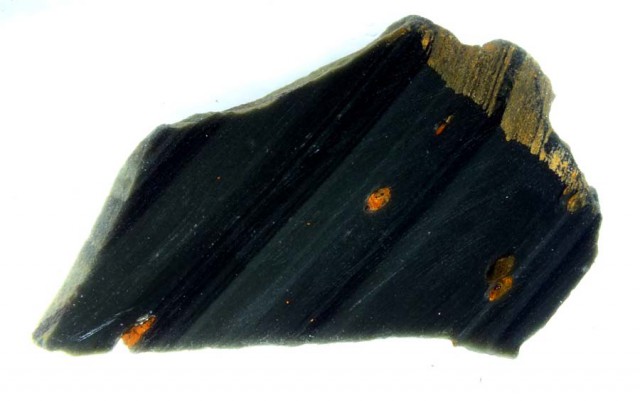
黒曜石:歴史、意味、特性、用途など
 息を呑むほど神秘的な宝石をお探しなら、黒曜石に勝るものはありません!美しい火山ガラスの一種である黒曜石は、家庭用品からジュエリーまで、私たちの日常生活に静かに溶け込んでいます。古代から人々は、その並外れた治癒力とスピリチュアルな象徴性に惹かれてきました。
息を呑むほど神秘的な宝石をお探しなら、黒曜石に勝るものはありません!美しい火山ガラスの一種である黒曜石は、家庭用品からジュエリーまで、私たちの日常生活に静かに溶け込んでいます。古代から人々は、その並外れた治癒力とスピリチュアルな象徴性に惹かれてきました。
この詳細なガイドでは、黒曜石の優れた品質と特徴の数々を詳しくご紹介します。これほど特別な石は、じっくりと見る価値があります!
黒曜石とは何ですか?
厳密に言えば、黒曜石は宝石ではなく、天然の火山ガラスの一種です。黒曜石が最も一般的ですが、他にも様々な種類の黒曜石が存在します。
黒曜石の種類

アパッチの涙
アパッチ・ティアーズは、滑らかで磨かれた表面を持つ丸い黒曜石です。アパッチ・ティアーズは、19世紀の有名な伝説、アパッチ族とアメリカ騎兵隊の戦いにちなんで名付けられました。
アパッチ族の戦士たちは、虐殺されるよりは崖から身を投げて自ら命を絶った。悲しみに打ちひしがれたアパッチ族の女たちは、黒い涙を流した。その涙は黒曜石へと変化した。
悲劇的な背景にもかかわらず、アパッチの涙は癒しと回復を象徴する美しい石です。
レインボーアンドファイアオブシディアン
色のついた黒曜石がお好みなら、虹色や火色の黒曜石がぴったりかもしれません。
虹色の黒曜石は、磁鉄鉱と呼ばれる鉄分を豊富に含む鉱物の含有により、鮮やかな色彩に満ちています。
ファイアーオブシディアンは、その名前にもかかわらず、燃えるようなオレンジ色の石ではありません。むしろ、虹色のオブシディアンに似た、驚くほど多様な色彩をしています。違いは?ファイアーオブシディアンは磁鉄鉱の薄い層を持ち、炎の虹色のような輝きを放ちます。
違いはありますが、レインボーオブシディアンはファイアオブシディアンのどちらも個性と色彩に満ちた大胆な石です。

スノーフレークオブシディアン
一年中冬のワンダーランドを夢見ていますか?雪の結晶のような黒曜石で、氷の魔法を体験してみませんか?
ご想像の通り、スノーフレークオブシディアンは、雪の結晶のような繊細な白い斑点が散りばめられています。冬がお好きな方には、スノーフレークオブシディアンは宝石コレクションに加えるのに最適な石です。

マホガニーオブシディアン
暖色系の宝石がお好みなら、赤褐色の縞模様や渦巻き模様が美しいマホガニーオブシディアンがおすすめです。マホガニーオブシディアンは、結晶形成時にヘマタイトなどの鉄不純物が混入することで、その希少な色彩を生み出します。

シーンオブシディアン
シーンオブシディアンは、まるで銀河を内包しているかのような、幽玄な石です。金と銀の微細な気泡が入り混じったシーンオブシディアンは、まさに神々しい美しさを放ちます。
黒曜石には多くの種類がありますが、それらはすべて特定の特徴と特性を共有しています。
黒曜石の仕様と特徴
黒曜石は主に二酸化ケイ素で構成されており、その含有量は約70%です。シリカは地球上で最も豊富な鉱物の一つです。砂やセメントからアメジストの宝石に至るまで、シリカは地球上に豊富に存在しています。
黒曜石の強度はどれくらいでしょうか? 鉱物のモース硬度スケールでは、黒曜石は蛍石のすぐ上の5と控えめな数値です。玄武岩ガラスの黒曜石は6と、それよりわずかに硬いです。
カラー:ブラック、シルバー、ゴールド、赤褐色、レインボー
骨折:貝殻状
光沢:ガラス質
透明性:透明から不透明
屈折率: 1.48~1.51(通常1.49)
密度: 2.25~3.00
胸の谷間:なし
黒曜石の持つ特性は何千年もの間、人類を魅了してきました。では、様々な文化は時代を超えて黒曜石をどのように利用してきたのでしょうか?
黒曜石の歴史
黒曜石の用途は旧石器時代にまで遡ります。脆く鋭い刃先を持つ黒曜石は、強力な槍や矢じり、その他の武器に加工されました。
時が経つにつれ、古代の人々は黒曜石を他の用途に使い始めました。当然のことながら、黒曜石のジュエリーは人気を博しました。黒曜石は台所用品やその他の家庭用品にも彫刻されました。一方、シャーマンやヒーラーは、黒曜石の霊的な力を信じて崇拝していました。
黒曜石という言葉が初めて登場するのは、西暦77年、ローマの博物学者大プリニウスの百科事典『博物誌』です。プリニウスは、黒曜石ガラスがエチオピアでオブシディウスという旅行者が発見した石に似ていると記しています。
黒曜石はマヤ帝国において特別な地位を占めていました。マヤ人は、他の人々が金を渇望するのと同じように、黒曜石を大切にしていました。マヤの商人は黒曜石を通貨として交換していました。マヤ人は黒曜石の鏡が未来を予言すると信じていました。
何世紀も後、アステカ帝国も黒曜石を崇拝するようになりました。アステカ人は、この印象的な火山ガラスを石の神イツリと結びつけました。
人々が黒曜石をどのように使用していたかはわかっていますが、そもそも黒曜石はどのようにして形成されるのでしょうか?
黒曜石の起源と産地
黒曜石は火と灰から生まれます。火山岩が冷えて固まると、微量のシリカが急速に浸透します。このプロセスが非常に速いため、火山岩は結晶ではなくガラスに変化します。一方、エメラルドやアメジストのような宝石は、結晶化するのに数千年かかることがあります。
黒曜石はどこで見つかりますか?
アメリカ合衆国は黒曜石の主要な産地であり、正確にはアリゾナ州、コロラド州、カリフォルニア州が産地です。他の州では、様々な種類の黒曜石が産出されています。例えば、ユタ州にはスノーフレーク黒曜石の鉱山があり、ニューメキシコ州ではアパッチ・ティアーズが産出されます。一方、オレゴン州にはファイアー・オブシディアン、マホガニー・オブシディアン、レインボー・オブシディアンの鉱床があります。
その他の黒曜石鉱山は世界中に点在しています。
メキシコ
ブラジル
エクアドル
アイスランド
インドネシア
イタリア
日本
起源を問わず、黒曜石はその独特の神秘的な力で多くの人々を魅了してきました。しかし、それはなぜでしょうか?黒曜石は何を象徴しているのでしょうか?

黒曜石の意味と用途
黒曜石は、平和、忍耐、自己愛、そして幸福に満ちた人生を約束すると言われています。では、黒曜石はスピリチュアルな意味でどのような意味を持つのでしょうか?そして、黒曜石の何がそんなに特別なのでしょうか?
誠実さを大切にするなら、黒曜石に導きを求めてみてください。黒曜石は、善も悪も、美しいものも醜いものも、混沌とした栄光に満ちた真実の象徴です。魂の光と闇の両方をより深く理解できるようになるでしょう。さらに、黒曜石は闇から目を背け、光と愛を受け入れる力を与えてくれるでしょう。
同様に、黒曜石は穏やかな忍耐力で、あらゆる攻撃的なエネルギーを鎮めることができます。その結果、困難を乗り越え、自己受容を発見できるようになるでしょう。
このように豊かなスピリチュアルな意味を持つ黒曜石が、世界中で多くの人々に大切にされているのも不思議ではありません。では、黒曜石は何に使われているのでしょうか?
古代と同じように、この滑らかで輝く石は、美しいジュエリーに仕上がっています。オブシディアンのネックレスやブレスレットは人気です。オブシディアンの婚約指輪や結婚指輪は、愛を称える素晴らしい贈り物です。
黒曜石はただ美しい宝石というだけではありません。古代と同様に、黒曜石は切削工具やマグカップ、食器などの台所用品にも使われてきました。黒曜石の鏡は主に装飾用として使われていますが、非常に人気があります。外科用メスさえも黒曜石で作られています!
実際、黒曜石の効能には、優れた霊的治癒力と治癒力が含まれています。「黒曜石をヒーリングにどう使うの?」と疑問に思われる方もいるかもしれません。
素晴らしい質問ですね!黒曜石の強力な治癒効果について詳しく見ていきましょう。

黒曜石のスピリチュアルな効果と治癒効果
他の治癒石と同様に、黒曜石には肉体的、感情的、精神的な治癒力があります。
身体の健康に関しては、黒曜石は消化器系のトラブルを和らげ、体内の毒素を排出する効果があります。関節炎、関節痛、こむら返りなどの痛みでお悩みですか?黒曜石が解決策になるかもしれません!
黒曜石は、心の健康を保つ効果もあります。ストレスに悩まされている方は、黒曜石を身近に置いてみてください。緊張がほぐれ、平穏と明晰さが訪れるかもしれません。
スピリチュアルなヒーリングはどうでしょうか?もしあなたの基本的な肉体的、感情的なニーズが満たされていないと感じているなら、ルートチャクラがブロックされている可能性があります。神聖なエネルギーセンターであるルートチャクラは、あなたを母なる自然、世界、そして人生そのものへと繋ぎ止めます。オブシディアンはルートチャクラのバランスを整え、再び自分の足場を見つけるのを助けてくれます。
黒曜石の癒しの力をどのように活用できるでしょうか?瞑想がお好きなら、次回は黒曜石を手に持って瞑想してみてください。黒曜石を持ち歩いたり、自宅やオフィスに置いておくのもおすすめです。
さて、話題を変えて黒曜石のユニークな特性について見ていきましょう。
黒曜石の購入要因
黒曜石を購入するときは、透明度、色、カット、カラット重量の 4 つの要素を考慮してください。
明瞭さ
レインボーオブシディアンに磁鉄鉱のインクルージョンが含まれていることを覚えていますか? インクルージョンとは、宝石の形成過程で内部に閉じ込められたガス、液体、その他の微粒子のことです。インクルージョンのない宝石は「アイクリーン」とみなされ、非常に人気があります。
黒曜石は通常、不透明で美しい輝きを放ちます。宝石職人は、透明度の高い黒曜石を鏡に加工することがよくあります。
しかし、すべての黒曜石が肉眼で見てきれいなわけではありません。石によっては、微結晶、気泡、針状結晶、雪片などの内包物が含まれている場合があります。レインボーオブシディアンの場合、内包物が色の決め手となります。
他の黒曜石の色はどうですか?
色
オブシディアンのトレードマークは、落ち着いたミッドナイトブラックです。しかし、黒が少し強すぎるという方も、他にもたくさんのオブシディアンカラーが揃っています!
黒曜石には、伝統的な黒色の外皮以外にも様々な種類があることについては既に触れました。金色、銀色、赤褐色、虹色など、黒曜石には実に様々な色合いがあります。
カット
かつて黒曜石は矢やその他の武器に加工されていました。今日では、装飾用の矢じりやその他の彫刻に加工されています。
黒曜石のジュエリーをお探しですか?黒曜石はファセットカット、タンブルカット、彫刻など様々な方法で加工できます。黒曜石は繊細なため、素材の美しさを最大限に引き出すため、通常はラウンドカット、オーバルカット、カボションカットに加工されます。黒曜石のカボションカットは、驚くほど滑らかで磨き上げられた美しい輝きを放ちます。
これらのジュエリーの大きさはどれくらいですか?
カラット重量
黒曜石は大きいものから小さいものまで、その中間の大きさまで様々です。極小サイズから数百カラットまで、実に様々です。黒曜石の彫刻をお求めなら、最大25cm(10インチ)にもなる場合があることをご承知おきください。
完璧な黒曜石を見つけたら、もう手放せなくなるはずです!では、黒曜石のお手入れはどうしたらいいのでしょうか?
黒曜石の手入れとメンテナンス
黒曜石は美しい一方で、脆い性質のため、特別なお手入れが必要です。黒曜石のジュエリーは、丁寧にお手入れすれば、何年も完璧な状態を保つことができます。
以下のヒントを必ず覚えておいてください:
黒曜石は傷がつかないよう、他の宝石から離して保管してください。布張りのジュエリーボックスの使用をご検討ください。
掃除、運動、スポーツをする前には、必ずジュエリーを外してください。黒曜石をぶつけるのは避けたいものです。
黒曜石のジュエリーを軽く掃除するには、糸くずの出ない布で優しく拭いてください。欠けたり壊れたりしないよう、強くこすらないようにしてください。
黒曜石を洗浄する際に水に浸けても大丈夫ですか?もちろんです!より深く洗浄するには、黒曜石をぬるま湯に浸し、中性洗剤と柔らかいブラシで優しくこすってください。ただし、スチーマーなどの機械洗浄機は黒曜石には刺激が強すぎるため、使用は避けてください。
厳しい話ですが、黒曜石の値段にひるむでしょうか?それとも、黒曜石は安いのでしょうか?

黒曜石の価格と価値
先ほど、黒曜石には地球上で最も豊富な鉱物の一つであるシリカが含まれているとお話ししました。おかげで黒曜石は豊富に手に入り、しかもお手頃価格なのです!
では、黒曜石の価格はいくらでしょうか?この艶やかな黒い宝石の価格は、1個あたり2ドルから100ドルと幅があります。1ポンド単位で購入すると、通常1ポンドあたり2ドルから5ドルです。
結局のところ、黒曜石は非常に手頃な価格なので、大金を費やすことはまずないでしょう。黒曜石のジュエリーを何点か買い集めたいとお考えですか? ぜひお試しあれ!
オブシディアンで人生を切り開こう
黒曜石は幾度となく万能な石であることが証明されてきました。旧石器時代の矢や槍から現代の台所用品や宝飾品に至るまで、黒曜石は私たちの世界に常に存在してきました。
素晴らしい種類がたくさんあるので、自分にぴったりの黒曜石を見つけるのは楽しくて簡単です!シャインオブシディアンで宇宙へ舞い上がるのもよし、スノーフレークオブシディアンで一年中クリスマスをお祝いするのもいいでしょう。どんな石を選んでも、きっと平和、希望、そして幸せが見つかるはずです!
黒曜石の購入をお考えですか?今すぐGem Rock Auctionsで黒曜石をご覧ください!
Gemstone Encyclopedia検索
最新記事
レインボーラティスサンストーンは、様々な内包物によって3つのゴージャスな光学的効果を持つ長石の一種です。燃えるように鮮やかな色合いと格子模様が、コレクターにとって希少な宝石となっています。
12th Jan 2026
チューライトは、ゾイサイト鉱物ファミリーに属する、鮮やかなバラ色の色合いを示す希少なノルウェー産の宝石で、ジュエリーのセッティングやペンダントによく使用されます。
6th Jan 2026
記事のカテゴリ
How To's is where you will find helpful articles from gem Rock Auctions on how to cut gemstones, select gemstones and buy gemstones.
9記事数



